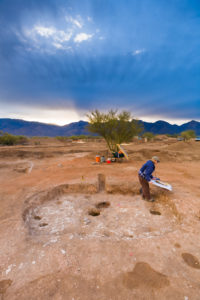
Celebrating the Past, Looking to the Future
R.J. Sliva mulls the end of 2016 and what historical preservation means to a community.
Legacy. What is a legacy?
It’s planting seeds in a garden you never get to see.
I wrote some notes at the beginning of a song someone will sing for me.
— “The World Was Wide Enough,” Hamilton
The legacy of America’s western lands is planted a bit more securely for the future as 2016 draws to a close, thanks to recent legislative and executive actions. On December 10, Congress passed the National Park Service Centennial bill, which includes the reauthorization of the National Historic Preservation Fund for the next seven years. Then, on December 28, President Obama designated the Bears Ears National Monument in southeastern Utah.
Why are these developments important? The things we delight in today—from the massive cliff dwellings of Tonto National Monument to the officers’ quarters at Fort Lowell to the funky converted 1920s brick storefront that now holds our favorite downtown brewery—are there for us to see because someone a generation or two or three ago decided that they should be preserved for the future instead of being demolished.

Postcards and photos showing the deterioration and destruction of the Convento, Mission San Agustin del Tucson: (top) 1907; (middle) 1937; (bottom (1967).
We feel this in acutely Tucson, where every historic structure stands in testament to ten more that have disappeared. We take visiting friends and family to see the reconstructed Presidio San Agustín del Tucson and proudly point out the segments of the original wall Desert Archaeology located, we continue on to the recreated gardens that are planted on the original Spanish mission site we excavated at the base of A-Mountain… and then we sigh, wave our hands in the general direction of the mountain, and talk about the large adobe chapel, convento, granary, and gardens that were built there in the 1770s, allowed to fall into ruin through the early 1900s, and eventually bulldozed mid-century to make way for a brickyard and landfill. And our history-seeking guests cock their heads at us like befuddled beagles and ask what in the world the city government was thinking.
Luckily, thanks to the NHPF, local governments and businesses increasingly are viewing historical and archaeological sites as value-enhancing resources to be incorporated into communities and preserved for future generations rather than obstacles to be bladed away.
In honor of this year’s 50th anniversary of the National Historic Preservation Act, the Making Archaeology Public project solicited videos that highlight publicly funded archaeological projects from across the nation. Arizona’s entry features a number of Desert Archaeology excavations in Tucson and Phoenix, along with commentary, photography, and artwork from several DAI staff members.
This kind of work performed by DAI and other cultural resources management companies, as required by the NHPA, allows people to glimpse through briefly opened windows into their past—check out the excited crowds looking at preserved 3,000-year-old footprints and throwing replica spears in the video—and provides the information needed for preserving or reconstructing architecture that both local residents and tourists can visit into perpetuity.

The winter solstice sun rises in alignment with the entryway to a Hohokam pithouse at Honey Bee Village.
The NHPF reauthorization helps assure that historical, archaeological, and traditional cultural properties will continue to be managed with careful consideration for at least the next seven years. During that time, we hope that people continue to learn about the crucial role these places play as the warp supporting the weft of our rich national tapestry, think about the resources we have lost, and encourage their representatives to continue to protect our legacy into the future.
Desert Archaeology looks forward to the year to come in the hope and anticipation of discovery as we continue our mission of documenting the past and planting the garden for the generations to come.

